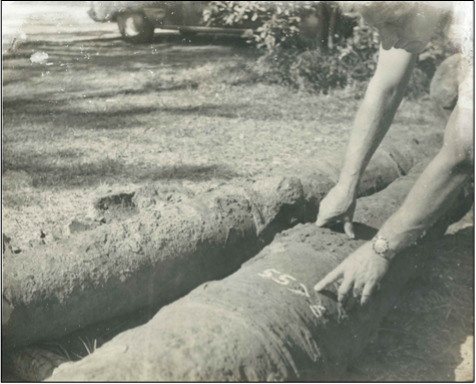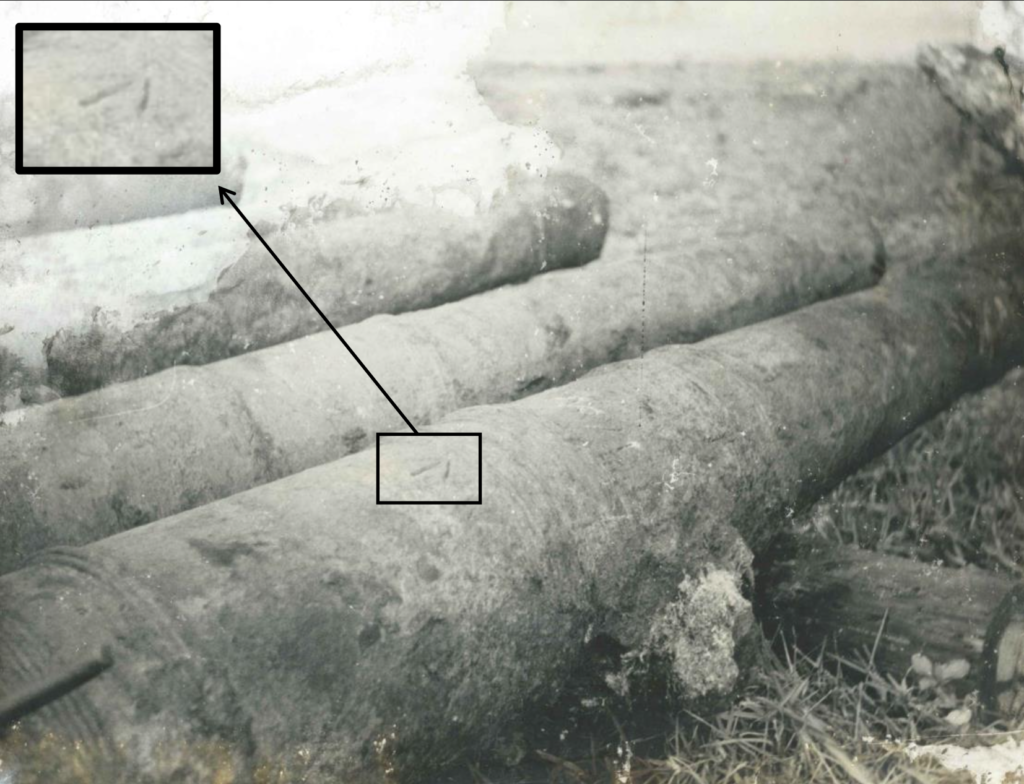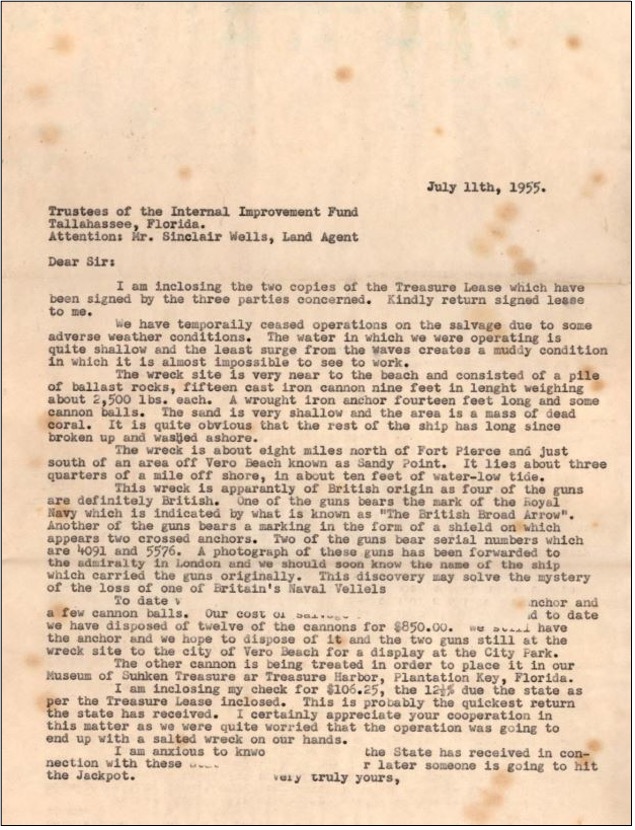Last month the Fleet Society was honored to publish an article authored by Jorge A. Proctor entitled “The Resting Places of the Capitana and Almiranta of the Tierra Firme Squadron, from the 1715 Fleet, Identified”. Now we are pleased to present Jorge’s latest article which can be accessed here. We hope that you enjoy his latest offering.
Cannon Markings from the Cannons Salvaged at Sandy Point in 1955
An update to the article “The Resting Places of the Capitana and Almiranta of the Tierra Firme Squadron, from the 1715 Fleet, Identified”
Jorge A. Proctor © 2022
Historical research involves the finding, collecting, interpreting, and evaluating data and evidence from primary and secondary sources, as well as additional correlating evidence from other sources, such as archaeological reports, artifacts, and scientific findings, to better assess and fully understand a particular past historical event, and the place or places where it took place, so that its story can be told in its proper context.

But not always do we have all the information available. So, as new information comes to light, many times stories need to be updated or revised. Such is the case in here.
As a result of the publication of the article “The Resting Places of the Capitana and Almiranta of the Tierra Firme Squadron, from the 1715 Fleet, Identified”, the 1715 Fleet Society received a message from fellow researcher Laura Strolia, which brought to my attention that the Miami Herald article from July 27, 1955 had an error. In addition, Ms. Strolia also asked about the two crossed anchors marking, which had been said in the same article from 1955 to have been used by the British Royal Navy, as from her research, she said that: “the crossed anchors suggest it had once been owned by a Dutch Admiralty. The emblem did not necessarily mean the cannon was Dutch, for a foundry of another nation, such as England, could have produced the gun for the Dutch Republic.”
With Ms. Strolia’s new information, a revisit to this subject was in order, which has now led to new finds. So, let’s begin by addressing the issue of what markings were seen on the cannons salvaged in 1955 at the Sandy Point shipwreck-site. The Miami Herald article from July 27, 1955, included that: “Four of the guns are definitely British, McKee said, and bear the crossed anchor emblem of the Royal Navy”. But this does not seem to have been completely true. According to an original letter from Art McKee Jr., dated July 11, 1955, published on pages 106 and 107 of the book Finding Treasure by Robert F. Westrick, which was brought to my attention by Laura Strolia, it was said that: “This wreck is apparently of British origin as four of the guns are definitely British. One of the guns bears the mark of the Royal Navy which is indicated by what is known as ‘The British Broad Arrow’. Another of the guns bears a marking in the form of a shield on which appears two crossed anchors. Two of the guns bear serial numbers which are 4091 and 5576.”
So, although the article was correct in saying that all four guns were reported as “definitely” being British, which is something we will further discuss later, all four markings on them were in fact different. So now that we have an accurate description of all four markings, let’s go back and study this in more detail.


Left: Art McKee Jr. pointing at serial number 5576 on one of the cannons salvaged.
Below: A broad arrow marking is clearly visible on the cannon in the foreground.

Image courtesy of Robert F. Westrick.
For starters, the cannon with the broad arrow marking was definitely a British Royal Navy gun. The broad arrow marking is known to have been used to denote the property of the English monarch. As for the two cannons with the serial numbers, or survey number, 4091 and 5576, communication with British cannonexpertRuth Rhynas Brown brought to my attention the existence of a great ordinance survey, conducted in the 1690’s on guns belonging to the British Ordinance Office, as assigned to British ships, shore batteries, and stored. This compendium of British ordinance is today kept at The National Archives (TNA), in the United Kingdom, under the records of the War Office: WO55/1736.
Although Colonel George Browne, Master Gunner of England (1696-1702) has been given credit for possibly organizing and managing this survey, leading to this work also being referred to as the “Browne Survey,” it is more likely that the survey was already being conducted at the time that he served his post, as the fourth-rate galley-frigate James Galley, commissioned in 1676, which wrecked on November 25, 1694, is included on the survey, indicating that this survey must have started before this date.
At the end, the survey was never completed. The survey does not include the guns in Irish fortresses and other remote locations; ships of 24-guns or less, for which only one ship is documented (the 24-gun six-rate ship Sun Prize); or guns from vessels that were not in port and could not be made available to the surveyors before the work ended. But still, 14,801 guns were surveyed and assigned numbers, making this a source of extraordinary value today (since two guns, even of the same type, seldom had identical weights, prior to this survey the Ordinance Board used weights of guns as unofficial identification numbers).
Ms. Ruth Rhynas Brown kindly looked through this survey for me and found both of these numbers. Cannon 4091 was said to be of Dutch origin (not necessarily of Dutch manufacture, but a gun documented as AA for previously belonging to the Admiralty of Amsterdam) and ranked as a spare at Woolwich. As for cannon 5576, this was a British cannon said to be, as of the date of this survey, aboard the 90-gun Second Rate ship-of-the-line of the Royal Navy, the Duke, at Chatham (the survey actually included 94-guns for the Duke, all documented in folios 92v-94r).
So, we now have positive confirmation that at least three of the four guns salvaged in 1955, were in possession of the Royal Navy, even if not all were British in origin. But what can we make of the cannon recorded as being aboard the Duke at the end of the 1690s? How did a gun once aboard the Duke, launched on June 13, 1682, at Woolwich Dockyard, ended up in the coast of Florida, on the shipwreck site of the Nuestra Señora del Carmen, which we know to be the former Royal Navy ship Hampton Court?
Our answer may be found in the year 1701. In 1701 the Duke was sent to the yards, where it underwent a complete rebuild to become a new 96-gun Second Rate ship-of-the-line, renamed Prince George on December 31, 1701. At the same time that the Duke was in the yards, the 70-gun British Third Rate ship-of-the-line Hampton Court was also brought in, to undergo a refit, and it is while both vessels were being refitted at Chatham, that the transfer of guns most have taken place.
The transfer of guns between Royal Navy vessels, or spare guns being assigned to vessels as upgrades or replacement of malfunctioning or unserviceable ones, is not an uncommon practice. One example of guns from one ship, being later found on another, was documented in the Introduction of the publication The Great Ordinance Survey of 1698: a facsimile by Richard Endsor and Frank Fox, who wrote: “quite a few of the prestigious brass guns (no longer manufactured in the 1690s due to their great cost) listed for the first-rate Royal William in the survey can be identified by their weights as previously aboard the famous Royal Charles (ex-Naseby) when she bore King Charles II to his restoration in 1660 (NA PRO 30/37/8).”
Finally, we need to talk about the cannon with the crossed anchors marking inside a shield-type device. Although the device does resemble the one used to denote cannons from the Dutch Admiralty, this cannot be confirmed on this cannon at this time. As per communication with Nico Brinck, expert on old cannons in the Netherlands and author of the book Kanonnen van Nederland, Nederlands geschut en andere oude kanonnen in Nederland, Guns of the Netherlands, Dutch cannon and other old guns in the Netherlands, the picture of the marking on this cannon, alone, did not provide enough information for him to come to a conclusion, and, since the whereabouts of this cannon has been lost since the 1950’s, a further examination will not be possible.
As per a Research Report by Nathan C. Henry, Assistant North Carolina State Archaeologist, lead conservator with the Underwater Archaeology Branch’s (UAB) preservation laboratory and the lead conservator for the Queen Anne’s Revenge (QAR) Project, “The two largest producers of cast iron artillery pieces in the last half of the seventeenth century and throughout the eighteenth century were England and Sweden. Ordnance export from both countries were prevalent throughout Europe and anywhere Europe traded. The reality is that the international ordnance trade was so complex that once the gun left the foundry they could end up on ships of any nationality.” In fact, several of the cannons salvaged from the shipwreck-site of the English ship the Queen’s Anne’s Revenge, discovered in Beaufort Inlet, North Carolina, have already been identified as either cast, or possibly cast, in foundries in Sweden, and cannon expert Nico Brinck has also documented cannons from the late 18th century which were cast in foundries in Sweden for the Dutch. So, although no conclusive confirmation for the place of origin of this gun can be established at this time, there is no reason why this could be a cannon manufactured outside of England, for which we have already seen that at least one other gun, which likely would have been original to this vessel when it was a British warship, and which was among the guns salvaged at this site in 1955, has now been identified, as per the 1690’s Ordnance Survey, as being of Dutch origin. The new evidence suggests that, at least in this case, if not throughout the War of Spanish Succession, the Spanish armament inspector was more concerned with documenting the number of cannons on the vessels, rather than the accuracy of their place of origin or caliber. This disparity seems to also suggest that the Spanish inspector who performed the 1712 armament inspections on the Nuestra Señora del Carmen and the Nuestra Señora del Rosario, just recorded the same nationality on cannons original to those vessels, as that of the vessels being inspected, for which, in both these cases, the vessels were known to be former British ships.
Bibliography:
Brinck, Nico. Facebook message to the author, Jorge A. Proctor. April 23, 2022.
Brinck, Nico. Kanonnen van Nederland, Nederlands geschut en andere oude kanonnen in Nederland, Guns of the Netherlands, Dutch cannon and other old guns in the Netherlands. Amersfoort, Netherlands: Cultural Heritage Agency (Rijksdienst voor het Cultureel Erfgoed), 2020.
Henry, Nathan C. Analysis of Armament from Shipwreck 31CR314: Queen Anne’s Revenge Site. Queen Anne’s Revenge Shipwreck Project. Research Report and Bulletin Series QAR-B-09-01. North Carolina Underwater Archaeology Branch, Raleigh, NC. June 2009.
Proctor, Jorge A. “The Resting Places of the Capitana and Almiranta of the Tierra Firme Squadron, from the 1715 Fleet, Identified”. 1715 Fleet Society Webpage, 2022, at: https://1715fleetsociety.com/the-resting-places-of-the-capitana-and-almiranta/
Rhynas Brown, Ruth. Facebook discussion on Group: Big Cannon Project. April 21, 2022.
Strolia, Laura. Quick Question about Cannon, email sent to Ben Costello, Director of the 1715 Fleet Society. April 19, 2022.
The Great Ordnance Survey of 1698: a facsimile. Introduction by Richard Endsor and Frank Fox. Florence, Oregon: SeaWatchBooks LLC, 2013.
Three Decks Forum, British Second Rate ship ‘Duke’ (1682) at: https://threedecks.org/index.php?display_type=show_ship&id=75
Three Decks Forum, British Third Rate ship ‘Hampton Court’ (1701) at: https://threedecks.org/index.php?display_type=show_ship&id=12044
Three Decks Forum, British Fourth Rate ship ‘James Galley’ (1676) at: https://threedecks.org/index.php?display_type=show_ship&id=4920
Three Decks Forum, British Second Rate ship ‘Prince George’ (1701) at: https://threedecks.org/index.php?display_type=show_ship&id=5945
Three Decks Forum, British Second Rate ship ‘Prince George’ (1723) at: https://threedecks.org/index.php?display_type=show_ship&id=5946
Three Decks Forum, British Second Rate ship ‘Prince George’ (1755) at: https://threedecks.org/index.php?display_type=show_ship&id=11060
Westrick, Robert F. Finding the Fleet: Before the Treasure Coast Became the “Treasure Coast”: The Shipwrecks, the Spanish Salvage Camps and the Men Who Discovered Them. New Iberia, Louisiana, 2015.
Winfield, Rif. British Warships in the Age of Sail, 1603-1714: Design, Construction, Careers and Fates. Vol. 1. Barnsley, UK: Seaforth Publishing. 2009.
Winfield, Rif. British Warships in the Age of Sail, 1714-1792: Design, Construction, Careers and Fates. Vol. 1. Barnsley, UK: Seaforth Publishing. 2007.
Newspaper Article:
“From Sunken British Ship: Florida Gets Treasure Cut”, The Miami Herald (Miami, FL, Ed.), July 27, 1955, Page 3-B.